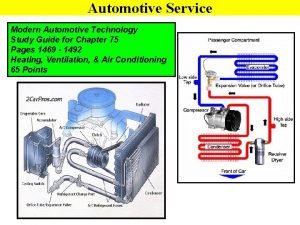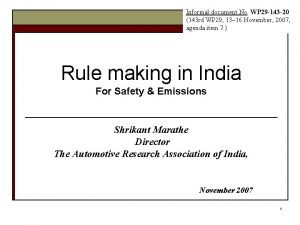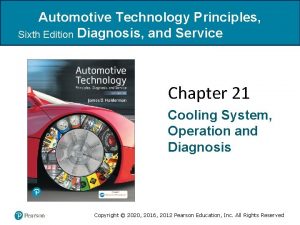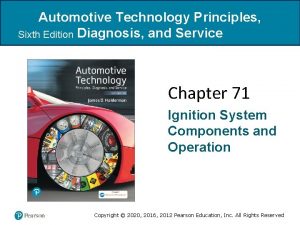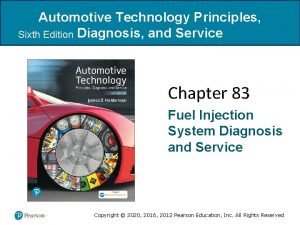Automotive Technology Principles Sixth Edition Diagnosis and Service















































- Slides: 47

Automotive Technology Principles, Sixth Edition Diagnosis, and Service Chapter 78 Oxygen Sensors Copyright © 2018, 2015, 2011 Pearson Education, Inc. All Rights Reserved Copyright © 2020, 2016, 2012 Pearson Education, Inc. All Rights Reserved

LEARNING OBJECTIVES (1 of 2) 78. 1 Discuss how O 2 S sensors work and describe the types of O 2 S sensors. 78. 2 Discuss the PCM uses for the O 2 S sensor. 78. 3 List the methods that can be used to test oxygen sensor. 78. 4 Describe the symptoms of a failed O 2 S sensor. Copyright © 2020, 2016, 2012 Pearson Education, Inc. All Rights Reserved

LEARNING OBJECTIVES (2 of 2) 78. 5 Describe testing on a post catalytic converter O 2 S sensor. 78. 6 Explain the operation of wide-band oxygen sensors. 78. 7 Compare dual cell wide-band sensors to single cell wide-band sensors. 78. 8 Describe wide-band oxygen pattern failures. Copyright © 2020, 2016, 2012 Pearson Education, Inc. All Rights Reserved

OXYGEN SENSORS (1 OF 3) • Purpose and Function – Automotive computer systems use an oxygen sensor in the exhaust system to measure the oxygen content of the exhaust. • Narrow Band – A conventional zirconia oxygen sensor (O 2 S) is only able to detect if the exhaust is richer or leaner than 14. 7: 1. Copyright © 2020, 2016, 2012 Pearson Education, Inc. All Rights Reserved

OXYGEN SENSORS (2 OF 3) • Construction – A typical zirconia oxygen sensor has the sensing element in the shape of a thimble; therefore, it is often referred to as one of the following: Thimble design, cup design, or finger design. • Operation – When the concentration of oxygen on the exhaust side of the thimble is low, a high voltage (0. 60 to 1. 0 V) is generated between the electrodes. As the oxygen concentration on the exhaust side increases, the voltage generated drops low (0. 0 to 0. 3 V). Copyright © 2020, 2016, 2012 Pearson Education, Inc. All Rights Reserved

OXYGEN SENSORS (3 OF 3) • There are several different designs of oxygen sensors, including: – – One-wire oxygen sensor Two-wire oxygen sensor Three-wire oxygen sensor Four-wire oxygen sensor • Heater Circuits – Conventional O 2 sensors requires 0. 8 to 2. 0 amperes at about 600°F (315°C). – Wide-band O 2 sensors require 8 to 10 amperes at 1200° to 1400°F (650°-760° C). Copyright © 2020, 2016, 2012 Pearson Education, Inc. All Rights Reserved

Figure 78. 1 Many oxygen sensors are located in the exhaust manifold near its outlet so that the sensor can detect the air-fuel mixture in the exhaust stream for all cylinders that feed into the manifold. Copyright © 2020, 2016, 2012 Pearson Education, Inc. All Rights Reserved

Figure 78. 2 (a) When the exhaust is lean, the output of a zirconia oxygen sensor is below 450 m. V. Copyright © 2020, 2016, 2012 Pearson Education, Inc. All Rights Reserved

Figure 78. 2 (b) When the exhaust is rich, the output of a zirconia oxygen sensor is above 450 m. V. Copyright © 2020, 2016, 2012 Pearson Education, Inc. All Rights Reserved

Figure 78. 3 Most conventional zirconia oxygen sensors and some wide-band oxygen sensors use the cup (finger) type of design. Copyright © 2020, 2016, 2012 Pearson Education, Inc. All Rights Reserved

Figure 78. 4 A typical heated zirconia oxygen sensor, showing the sensor signal circuit that uses the outer (exhaust) electrode as the negative and the ambient air side electrode as the positive. Copyright © 2020, 2016, 2012 Pearson Education, Inc. All Rights Reserved

Figure 78. 5 The oxygen sensor provides a quick response at the stoichiometric air-fuel ratio of 14. 7: 1. Copyright © 2020, 2016, 2012 Pearson Education, Inc. All Rights Reserved

QUESTION 1: ? How does an oxygen sensor report the level of oxygen in the exhaust? Copyright © 2020, 2016, 2012 Pearson Education, Inc. All Rights Reserved

ANSWER 1: When the oxygen level is low, the sensor generates a voltage above 450 m. V. When the oxygen level is high, the oxygen sensor generates a voltage below 450 m. V. Copyright © 2020, 2016, 2012 Pearson Education, Inc. All Rights Reserved

TITANIA OXYGEN SENSOR • The titania (titanium dioxide) oxygen sensor does not produce a voltage, but rather changes resistance due to the presence of oxygen in the exhaust. • As with a zirconia oxygen sensor, the voltage signal is above 450 m. V when the exhaust is rich and low (below 450 m. V) when the exhaust is lean. Copyright © 2020, 2016, 2012 Pearson Education, Inc. All Rights Reserved

FREQUENTLY ASKED QUESTION Copyright © 2020, 2016, 2012 Pearson Education, Inc. All Rights Reserved

Figure 78. 6 Number and label designations for oxygen sensors. Bank 1 is the bank where cylinder 1 is located. Copyright © 2020, 2016, 2012 Pearson Education, Inc. All Rights Reserved

PCM USES OF THE OXYGEN SENSOR • Fuel Control – The upstream oxygen sensors are among the highauthority sensors used for fuel control while operating in closed loop. • Fuel Trim – The fuel trim numbers are determined from the signals by the oxygen sensor(s). – Fuel trim can be negative (subtracting fuel) or positive (adding fuel). Copyright © 2020, 2016, 2012 Pearson Education, Inc. All Rights Reserved

OXYGEN SENSOR DIAGNOSIS (1 OF 2) • PCM System Tests – The PCM uses the oxygen sensor to test the EGR system, the catalytic converter, and the fuel system. • Visual Inspection – Black sooty deposits usually indicate a rich air-fuel mixture. – White chalky deposits are characteristic of silica contamination. – White sandy or gritty deposits are characteristic of antifreeze (ethylene glycol) contamination. Copyright © 2020, 2016, 2012 Pearson Education, Inc. All Rights Reserved

OXYGEN SENSOR DIAGNOSIS (2 OF 2) • Digital Voltmeter Testing – The oxygen sensor can be checked for properation using a digital high-impedance voltmeter. • Min/Max Testing – A digital meter set on DC volts can be used to record the minimum and maximum voltage with the engine running. • Scan Tool Testing – Using a scan tool, observe the oxygen sensor voltages. • Scope testing – The voltage signal of the sensor should be constantly changing. Copyright © 2020, 2016, 2012 Pearson Education, Inc. All Rights Reserved

Figure 78. 7 The OBD-II catalytic converter monitor compares the signals of the upstream and downstream oxygen sensor to determine converter efficiency. Copyright © 2020, 2016, 2012 Pearson Education, Inc. All Rights Reserved

Figure 78. 8 Testing an oxygen sensor using a DMM set on DC volts. With the engine operating in closed loop, the oxygen voltage should read over 800 m. V and lower than 200 m. V and be constantly fluctuating. Copyright © 2020, 2016, 2012 Pearson Education, Inc. All Rights Reserved

Figure 78. 9 Using a digital multimeter to test an oxygen sensor using the MIN/MAX record function of the meter. Copyright © 2020, 2016, 2012 Pearson Education, Inc. All Rights Reserved

Figure 78. 10 Connecting a handheld digital storage oscilloscope to an oxygen sensor signal wire. Check the instructions for the scope as some require the use of a filter to be installed in the test lead to reduce electromagnetic interference that can affect the oxygen sensor waveform. Copyright © 2020, 2016, 2012 Pearson Education, Inc. All Rights Reserved

Figure 78. 11 The waveform of a good oxygen sensor as displayed on a digital storage oscilloscope (DSO). Note that the maximum reading is above 800 m. V and the minimum reading is less than 200 m. V. Copyright © 2020, 2016, 2012 Pearson Education, Inc. All Rights Reserved

QUESTION 2: ? What are three ways to test an oxygen sensor? Copyright © 2020, 2016, 2012 Pearson Education, Inc. All Rights Reserved

ANSWER 2: With a multimeter, a scan tool or an oscilloscope. Copyright © 2020, 2016, 2012 Pearson Education, Inc. All Rights Reserved

POST CATALYTIC CONVERTER OXYGEN SENSOR TESTING • The oxygen sensor located behind the catalytic converter is used on OBD-II vehicles to monitor converter efficiency. • If the converter is working correctly, the oxygen content after the converter should be fairly constant. • The post catalytic converter oxygen sensor also is used to modify the amount of fuel delivered to the engine to allow the converter to work efficiently. Copyright © 2020, 2016, 2012 Pearson Education, Inc. All Rights Reserved

Figure 78. 12 The post catalytic converter oxygen sensor should display very little activity if the catalytic converter is efficient. Copyright © 2020, 2016, 2012 Pearson Education, Inc. All Rights Reserved

WIDE-BAND OXYGEN SENSORS (1 OF 2) • Terminology – Wide-band oxygen sensors have various names, depending on the vehicle and/or oxygen sensor manufacturer, including: broadband, wide-band, air-fuel sensor, lean air-fuel sensor. • Introduction – The need for more stringent exhaust emission standards require more accurate fuel control than can be provided by a traditional oxygen sensor. Copyright © 2020, 2016, 2012 Pearson Education, Inc. All Rights Reserved

WIDE-BAND OXYGEN SENSORS (2 OF 2) • Purpose and Function – A wide-band oxygen sensor is capable of supplying airfuel ratio information to the PCM over a much broader range. • Planar Design – A wide-band oxygen sensor that is flat and thin (1. 5 mm or 0. 006 inch). – The thin design makes it easier to heat and allows closed loop operation in less than 10 seconds. Copyright © 2020, 2016, 2012 Pearson Education, Inc. All Rights Reserved

Figure 78. 13 A conventional zirconia oxygen sensor can only reset to exhaust mixtures that are richer or leaner than 14. 7: 1 (lambda 1. 00). Copyright © 2020, 2016, 2012 Pearson Education, Inc. All Rights Reserved

Figure 78. 14 A planar design zirconia oxygen sensor places all of the elements together, which allows the sensor to reach operating temperature quickly. Copyright © 2020, 2016, 2012 Pearson Education, Inc. All Rights Reserved

DUAL-CELL PLANAR WIDE-BAND SENSOR OPERATION (1 OF 2) • Construction – A dual-cell, planar-type, wide-band oxygen sensor is made like a conventional planar O 2 S, or Nernst cell. Above the Nernst cell is another zirconia layer with two electrodes, called the pump cell. • Operation – Oxygen sensors do not measure the quantity of free oxygen in the exhaust. Instead, oxygen sensors produce a voltage that is based on the ion flow between the platinum electrodes of the sensor to maintain a stoichiometric balance. Copyright © 2020, 2016, 2012 Pearson Education, Inc. All Rights Reserved

DUAL-CELL PLANAR WIDE-BAND SENSOR OPERATION (2 OF 2) • Stoichiometric – When the exhaust is at stoichiometric (14. 7: 1 air-fuel ratio), the voltage of the Nernst cell is 450 m. V (0. 45 V). – The voltage between the diffusion chamber and the air reference chamber changes from 0. 45 V. This voltage is: § Higher if the exhaust is rich § Lower if the exhaust is lean – The reference voltage remains constant, but varies by vehicle. Copyright © 2020, 2016, 2012 Pearson Education, Inc. All Rights Reserved

Figure 78. 15 The reference electrodes are shared by the Nernst cell and the pump cell. Copyright © 2020, 2016, 2012 Pearson Education, Inc. All Rights Reserved

Figure 78. 16 When the exhaust is rich, the PCM applies a negative current into the pump cell. Copyright © 2020, 2016, 2012 Pearson Education, Inc. All Rights Reserved

Figure 78. 17 When the exhaust is lean, the PCM applies a positive current into the pump cell. Copyright © 2020, 2016, 2012 Pearson Education, Inc. All Rights Reserved

DUAL-CELL DIAGNOSIS • Scan Tool Diagnosis – Most service information specifies that a scan tool be used to check the wide-band oxygen sensor, because the PCM performs tests of the unit and can identify faults. • Digital Meter Testing – Check service information and determine the circuit and connector terminal identification. – Measure the calibration resistor for opens and shorts. Copyright © 2020, 2016, 2012 Pearson Education, Inc. All Rights Reserved

Figure 78. 18 Testing a dual-cell, wide-band oxygen sensor can be done using a voltmeter or a scope. The meter reading is attached to the Nernst cell and should read stoichiometric (450 m. V) at all times. The scope is showing activity to the pump cell with commands from the PCM to keep the Nernst cell at 14. 7: 1 air-fuel ratio. Copyright © 2020, 2016, 2012 Pearson Education, Inc. All Rights Reserved

SINGLE-CELL WIDE-BAND OXYGEN SENSORS • Construction – A typical single-cell wide-band oxygen sensor looks similar to a conventional four-wire zirconia oxygen sensor, and is referred to as an air-fuel sensor. • Milliammeter Testing – Zero (0 m. A) represents lambda or stoichiometric air-fuel ratio of 14. 7: 1 – +10 m. A indicates a lean condition – – 10 m. A indicates a rich condition • Scan Tool Testing – The scan tool displays the voltage, but varies by vehicle. Copyright © 2020, 2016, 2012 Pearson Education, Inc. All Rights Reserved

Figure 78. 19 A single-cell, wide-band oxygen sensor has four wires with two for the heater and two for the sensor itself. The voltage applied to the sensor is 0. 4 V (3. 3− 2. 9 = 0. 4) across the two leads of the sensor. Copyright © 2020, 2016, 2012 Pearson Education, Inc. All Rights Reserved

Figure 78. 20 A scan tool can display various voltages, but often shows 3. 3 V because the PCM is controlling the sensor through applying a low current to the sensor to achieve balance. Copyright © 2020, 2016, 2012 Pearson Education, Inc. All Rights Reserved

WIDE-BAND OXYGEN SENSOR PATTERN FAILURES • Most of the failures cause a DTC to set, usually causing the malfunction indicator (check engine) lamp to light. • However, one type of failure may not set a DTC, such as when the following occurs. – Voltage from the heater circuit bleeds into the Nernst cell. – This voltage causes the engine to operate extremely lean and may or may not set a DTC. Copyright © 2020, 2016, 2012 Pearson Education, Inc. All Rights Reserved

QUESTION 3: ? How are diagnostics performed on a wide-band dual-cell oxygen sensor? Copyright © 2020, 2016, 2012 Pearson Education, Inc. All Rights Reserved

ANSWER 3: Diagnostics are performed with a scan tool or a multimeter. Copyright © 2020, 2016, 2012 Pearson Education, Inc. All Rights Reserved

Copyright © 2020, 2016, 2012 Pearson Education, Inc. All Rights Reserved
 Automotive technology principles diagnosis and service
Automotive technology principles diagnosis and service Automotive technology sixth edition
Automotive technology sixth edition Principles of economics sixth edition
Principles of economics sixth edition Peter piper tongue twister
Peter piper tongue twister Rubber baby buggy bumpers tongue twister lyrics
Rubber baby buggy bumpers tongue twister lyrics Automotive heating and air conditioning 8th edition
Automotive heating and air conditioning 8th edition Biochemistry sixth edition
Biochemistry sixth edition Automotive engines 8th edition
Automotive engines 8th edition China automotive technology and research center
China automotive technology and research center Computer architecture a quantitative approach sixth edition
Computer architecture a quantitative approach sixth edition Apa sixth edition
Apa sixth edition Computer architecture a quantitative approach 6th
Computer architecture a quantitative approach 6th Precalculus sixth edition
Precalculus sixth edition Computer architecture a quantitative approach sixth edition
Computer architecture a quantitative approach sixth edition Nursing process
Nursing process Medical diagnosis and nursing diagnosis difference
Medical diagnosis and nursing diagnosis difference Nursing diagnosis three parts
Nursing diagnosis three parts Medical diagnosis and nursing diagnosis difference
Medical diagnosis and nursing diagnosis difference Modern automotive technology answer key
Modern automotive technology answer key Control system
Control system Mechanical technology automotive grade 11
Mechanical technology automotive grade 11 Bob caat
Bob caat Rivet split pin dublin
Rivet split pin dublin Sixth sense technology seminar report
Sixth sense technology seminar report Sixth sense technology seminar
Sixth sense technology seminar Sixth sense ted
Sixth sense ted Perbedaan diagnosis gizi dan diagnosis medis
Perbedaan diagnosis gizi dan diagnosis medis Chapter 81 brake system technology answers key
Chapter 81 brake system technology answers key Using mis (10th edition) 10th edition
Using mis (10th edition) 10th edition Using mis 10th edition
Using mis 10th edition Computer security principles and practice
Computer security principles and practice Computer security principles and practice 4th edition
Computer security principles and practice 4th edition Expert systems: principles and programming, fourth edition
Expert systems: principles and programming, fourth edition Food and beverage service' 9 th edition
Food and beverage service' 9 th edition Food and beverage service' 9 th edition
Food and beverage service' 9 th edition New wave brasserie (gastrodome)
New wave brasserie (gastrodome) Food and beverage management notes
Food and beverage management notes Food and beverage service methods
Food and beverage service methods Qqq tea
Qqq tea Information technology project management 9th edition
Information technology project management 9th edition Blue project chapter 5
Blue project chapter 5 Ethics in information technology 6th edition answers
Ethics in information technology 6th edition answers Ethics in information technology fourth edition
Ethics in information technology fourth edition Project management quality control
Project management quality control Project management chapter 6
Project management chapter 6 Basic environmental technology
Basic environmental technology Information technology project management 9th edition
Information technology project management 9th edition Automotive regulations and standards
Automotive regulations and standards


















